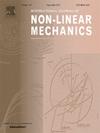基于bouc - wen -双线性模型和事件驱动稳态响应灵敏度法的搭接节点参数辨识
IF 2.8
3区 工程技术
Q2 MECHANICS
International Journal of Non-Linear Mechanics
Pub Date : 2025-06-04
DOI:10.1016/j.ijnonlinmec.2025.105157
引用次数: 0
摘要
追求准确地表示关节界面的摩擦行为导致了许多Iwan模型的发展,每个模型都以其独特的密度函数来区分。然而,由于与界面特性相关的认知不确定性,推导最准确地表示螺栓连接摩擦滞后的密度函数仍然是一个重大挑战。本文提出了一种新的Bouc-Wen-Bilinear (BWB) iwan型模型,该模型参数直接从滞后曲线中识别,而不是依赖于特定的密度函数。该模型采用Bouc-Wen模型来模拟节理界面的微滑移行为,而不是采用密度函数的积分公式。为了校准搭接式接头,将稳态响应数据与事件驱动灵敏度分析方法相结合,准确捕获螺栓连接中固有的主要摩擦机制,从而产生定制的事件驱动稳态响应灵敏度方法。此外,提出了一种归一化技术,并将其纳入定制方法中,以解决模型参数与响应变量之间的数量级差异。数值模拟和实验研究表明,所提出的BWB模型能有效地表征搭接节点的摩擦迟滞。本文章由计算机程序翻译,如有差异,请以英文原文为准。
Parameter identification of lap-type joints based on Bouc–Wen–Bilinear model and event-driven steady-state response sensitivity method
The pursuit of accurately representing the frictional behavior of joint interfaces has led to the development of numerous Iwan models, each distinguished by its unique density function. However, deriving the density function that most accurately represents the frictional hysteresis in bolted joints is still a significant challenge, primarily due to epistemic uncertainties associated with interface characteristics. This paper proposes a novel Bouc–Wen–Bilinear (BWB) Iwan-type model, wherein the model parameters are identified directly from hysteretic curves rather than relying on specific density functions. This novel model simulates the micro-slip behavior of the joint interfaces by the Bouc–Wen model instead of the integral formulation of density functions. To calibrate lap-type joints, steady-state response data, accurately capturing the dominant friction mechanisms inherent in bolted joints, is integrated with an event-driven sensitivity analysis method, resulting in a tailored event-driven steady-state response sensitivity method. Furthermore, a normalization technique is proposed and incorporated into the tailored method to address the order-of-magnitude discrepancies between model parameters and response variables. Numerical simulations and experiment studies show that the proposed BWB model efficiently represents the frictional hysteresis of lap-type joints.
求助全文
通过发布文献求助,成功后即可免费获取论文全文。
去求助
来源期刊
CiteScore
5.50
自引率
9.40%
发文量
192
审稿时长
67 days
期刊介绍:
The International Journal of Non-Linear Mechanics provides a specific medium for dissemination of high-quality research results in the various areas of theoretical, applied, and experimental mechanics of solids, fluids, structures, and systems where the phenomena are inherently non-linear.
The journal brings together original results in non-linear problems in elasticity, plasticity, dynamics, vibrations, wave-propagation, rheology, fluid-structure interaction systems, stability, biomechanics, micro- and nano-structures, materials, metamaterials, and in other diverse areas.
Papers may be analytical, computational or experimental in nature. Treatments of non-linear differential equations wherein solutions and properties of solutions are emphasized but physical aspects are not adequately relevant, will not be considered for possible publication. Both deterministic and stochastic approaches are fostered. Contributions pertaining to both established and emerging fields are encouraged.

 求助内容:
求助内容: 应助结果提醒方式:
应助结果提醒方式:


